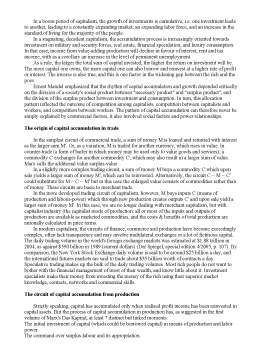Extras din referat
Macroeconomics is a branch of economics that deals with the performance, structure, and behavior of a national or regional economy as a whole. Along with microeconomics, macroeconomics is one of the two most general fields in economics. Macroeconomists study aggregated indicators such as GDP, unemployment rates, and price indexes to understand how the whole economy functions. Macroeconomists develop models that explain the relationship between such factors as national income, output, consumption, unemployment, inflation, savings, investment, international trade and international finance. In contrast, microeconomics is primarily focused on the actions of individual agents, such as firms and consumers, and how their behavior determines prices and quantities in specific markets.
While macroeconomics is a broad field of study, there are two areas of research that are emblematic of the discipline: the attempt to understand the causes and consequences of short-run fluctuations in national income (the business cycle), and the attempt to understand the determinants of long-run economic growth (increases in national income).
Macroeconomic models and their forecasts are used by both governments and large corporations to assist in the development and evaluation of economic policy and business strategy.
Macroeconomics changed between the early 1960's and the late 1970's. The macroeconomics of the early 1960's was avowedly Keynesian. This was manifested in the textbooks of the time, which showed a remarkable unity from the introductory through the graduate levels. John Maynard Keynes appeared, posthumously, on the cover of Time Magazine. Even Milton Friedman was famously—although perhaps misleadingly quoted, “We are all Keynesians now.” A little more than a decade later Robert Lucas and Thomas Sargent (1979) had published “After Keynesian Macroeconomics.” The love-fest was over.
The decline of the old-style Keynesian economics was due in part to the simultaneous rise in inflation and unemployment in the late 1960's and early 1970's. That occurrence was impossible to reconcile with the simple non-accelerationist Phillips Curves of the time.
But Keynesian economics also declined because of a change in economic methodology. The Keynesians had emphasized the dependence of consumption on disposable income, and similarly, of investment on current profits and current cash flow. They posited a Phillips Curve, where nominal—rather than real—wage inflation depended upon the unemployment rate, which was used as an indication of the looseness of the labor market. They based these functions on their own introspection regarding how the various actors in the economy would behave. They also brought some discipline into their judgments by estimating statistical relations.
But a new school of thought, based on classical economics, objected to the casual ways of these folks. New Classical critics of Keynesian economics insisted instead that these relations be derived from fundamentals. They said that macroeconomic relationships should be derived from profit-maximizing by firms and from utility-maximizing by consumers with economic arguments in their utility functions.
The new methodology had a profound effect on macroeconomics. Five separate neutrality results overturned aspects of macroeconomics that Keynesians had previously considered incontestable. These five neutralities are: the independence of consumption and current income (the life-cycle permanent income hypothesis); the irrelevance of current profits to investment spending (the Modigliani-Miller theorem); the long-run independence of inflation and unemployment (natural rate theory); the inability of monetary policy to stabilize output (the Rational Expectations hypothesis); and the irrelevance of taxes and budget deficits to consumption (Ricardian equivalence). These results fly in the face of Keynesian economics.
They undermine its conclusions about the behavior of the economy and the impact of stabilization policy.
The discovery of these five neutrality propositions surprised macroeconomists. They had not suspected that radically anti-Keynesian conclusions were the logical outcome of such seemingly-innocuous maximizing assumptions.
The accumulation of capital refers simply to the gathering or amassment of objects of value; the increase in wealth; or the creation of wealth. Capital can be generally defined as assets invested for profit or consumption.
In economics, accounting and Marxian economics, capital accumulation is often equated with investment, especially in real capital goods. The concentration and centralisation of capital are two of the results of such accumulation.
But capital accumulation can refer variously to:
• working and consuming less than earned--saving or accumulating the residual
• relying on the effects of compound interest to increase initial capital
• real investment in tangible means of production.
• financial investment in assets represented on paper
• investment in non-productive physical assets such as residential real estate that appreciate in value
consuming less than produced by productive assets like farm land--saving or accumulating the residual
• "human capital accumulation," i.e., new education and training increasing the skills of the (potential) labour force.
Non-financial and financial capital accumulation is usually needed for economic growth, since additional production usually needs additional money to enlarge the scale of production. Smarter and more productive organization of production can also increase production without increased capital. Capital can be created without increased investment by inventions or improved organization that increase productivity, discoveries of assets --oil, gold, minerals, etc., sale of property, etc.
In modern macroeconomics and econometrics the term capital formation is often used in preference to "accumulation", though UNCTAD refers nowadays to "accumulation".
Preview document
Conținut arhivă zip
- Capital Accumulation.doc


















